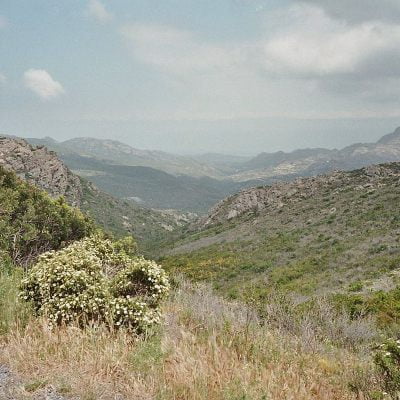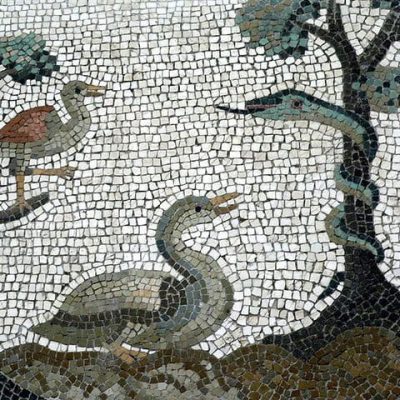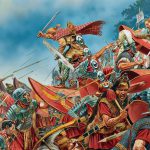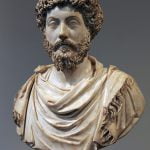Chapters
Deforestation during the Roman period resulted from the territorial expansion of the Empire, the enlargement of its population, large-scale agriculture and rapid economic development. Rome led Western Europe to a large extent towards development, which resulted in heavy deforestation around the Mediterranean.
The basic building material in the Roman period was wood. Trees were felled to provide homes for the ever-expanding population of the Roman Empire. When some Mediterranean houses were built of brick and stone, the roof and floors were covered with wood.
At its height, the Roman Empire is thought to have had about 60 million people, when the capital city itself had a population of one million or more (this figure was only reached by London in the 19th century). Such a large population, supplemented by the rapid development and improvement of the standard of living, and hence greater consumption, began to require more and more raw materials over time.
Energy sources
Wood was the main source of heating and industry. Wood as an energy source accounted for about 90% of total consumption and it was a significant factor in the widespread deforestation. Wood was used in mines, steel mills and in the production of ceramics. Wood and coal were the main ancient fuels in households, public buildings, thermal baths, and enterprises producing light and heat.
First, the areas closest to the mines, consuming all-natural resources in the immediate vicinity, were felled. When all energy sources were used up, raw materials were transported from other regions to ensure the continuity of the operation of the smelters and furnaces in the mines. Eventually, such industrial centres were relocated to another, more forested region, where the whole process was repeated. Mass felling of trees for the so-called Pontic Mud led to an imbalance in the natural balance of the environment. The Roman demand for wood led to deforestation and, consequently, erosion. Most of the territory of the Pontine Marshes was swamp-covered and unmovable during the Roman period.
Agriculture
The Roman Empire based its economy to a large extent on agriculture. With the increasing population, the need to feed a huge mass of people grew. For this purpose, forests were cut down and the fertile land was devoted to cultivation.
Agriculture produced commodities (by the hands of slaves or free peasants) that raised the living standards of the Romans. As a result of this year, 111 BCE Roman law allowed anyone who occupied state lands up to 20 acres (81,000 m2) to keep them, provided that they farmed the land. Such a policy of the Roman state caused a rapid process of deforestation as well as raised the awareness of the Romans of the important position agriculture occupied in the Roman economy.
The Romans, conquering new lands and provinces, turned them into arable fields in order to be able to feed the proletariat with their crops. The Romans pursued a policy of exploitation. Provinces with fertile soil became Rome’s granaries. With time, such still-cultivated lands lost their fertility and became wastelands or swamps. The population of such lands often suffered from hunger as all goods were shipped to the capital.
Egypt, whose ever-flooding Nile ensured constant, high yields that guaranteed food also for the local population. This province was privately owned by the emperor, and no senator or commander could go there without special permission. There was a fear in this region of a revolt that could block grain deliveries to the capital and thus cause hunger.
Latium, Campania, Sardinia, Sicily, Spain, and North Africa, as Roman granaries were exploited only to provide food for the masses. Desolate lands in Latium and Campania turned into swamps, once wooded mountains became “bald” hills when North Africa (except the Nile) became deserts.
Animals and grazing
The grazing of farm animals made a large contribution to the degradation of the environment during the Roman era. The grazing animals destroyed the woodlands to create the basis for cultivation. In the Greco-Roman world, there were four important species of farm animals: cattle, sheep, goats and pigs. Their combined “activity” in the selected area had a destructive impact on the environment. Shepherds were deliberately removing trees. Then the pigs were grazed, which ate on acorns, chestnuts, and beechnuts, which prevented the trees from reproducing. Sheep ate the green grass to the ground. Goats eat everything, but they were mainly used to eat bushes and young trees. It is worth noting that the goats were easy to breed and care for, and therefore their habitat extended to the entire Mediterranean area. It was mainly goat grazing that destroyed mountainous regions.
The consumption of mountain plants and saplings resulted in erosion, soil disappearance and the appearance of bare rock. Silt and gravel were washed off the mountains, which additionally resulted in flooding, siltation and the formation of swamps.
Military and shipbuilding
Forests throughout human history have been great places for ambush and hiding for enemy troops. Julius Caesar himself had the forest cut down more than once to prevent sneaky attacks on his troops. In addition, the areas through which the legions marched were also deforested, for which special units at the head of the column were responsible. The scope of such works was enormous given the constant relocation of troops, which at the end of the Empire amounted to nearly 600,000.
Wood was used on a massive scale also naturally in the shipbuilding industry. A large number of conflicts, a large sea area under control and sea trade required huge reserves of wood for the construction of warships, merchants and transport ships.
The influence of the Romans on the ecosystem
The influence of Roman culture on the state of the ecosystem of the Mediterranean region under Roman rule can be seen with the naked eye. A great example is macchia also known as macchia, which is a secondary plant formation found in wetter habitats in the Mediterranean. It was created in the place of sclerophyllous, mainly oak forests, destroyed by the Romans. Hence, Italia is largely a low forested area dominated by shrubs. Continuous cultivation of land resulted in the formation of wastelands and swamps. There were also natural disasters: floods (even Rome was affected by this; the first, large flood was recorded in 241 BCE), mudslides, and famines.
The Romans also influenced air poisoning. A large number of industrial centres required large supplies of fuel (coal, wood), and thus the air was poisoned with excreta from furnaces and steel mills. Of course, the mentioned effects of the activities of the Romans do not have the scale of today’s civilization. However, it should be noted that for those times the Roman civilization could be considered one of the least eco-friendly in the world. Sam Cicero stated that humans are masters of using what nature has given us, and all the things man uses in the world were created for the sake of human good.








